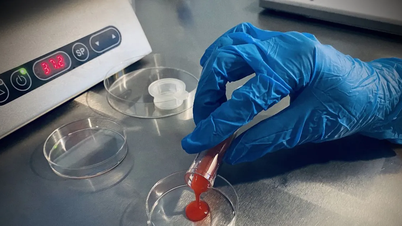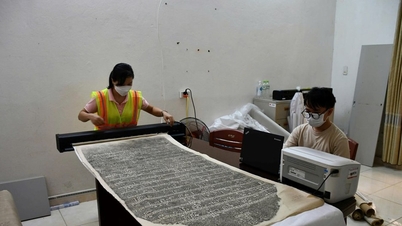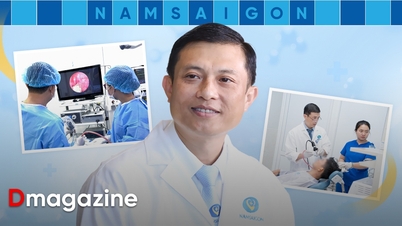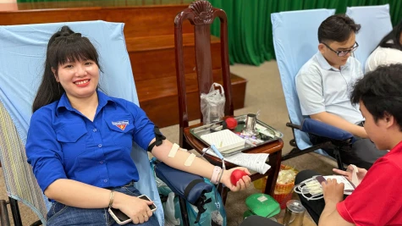An IVF cycle is a long treatment process.
Sharing at a recent online discussion with the topic: "Repeated failure of in vitro fertilization (IVF) - Causes and solutions", Dr. Pham Thi Thuy Duong, Director of the Hong Ngoc Yen Ninh IVF Reproductive Support Center, said that the concept of in vitro fertilization (IVF) is now very popular.
However, to perform this method effectively, there are many different ways to suit the conditions, constitution and specific health status of each couple.
“There are many factors that can influence the success of an IVF cycle. First of all, it is important to understand that an IVF cycle is a long-term treatment process, starting with careful preparation for both the wife and husband.
Preparing both of you physically is very important, helping your body be in the best condition before entering the procedure," said Dr. Duong.
Next is the ovarian stimulation process, which must be performed to optimize the development of the follicles. The egg retrieval technique must be precise to obtain the optimal number of eggs. At the same time, the husband also needs to prepare the best sperm, ensuring quality to increase the chance of successful fertilization.
In the laboratory, the process of embryo culture plays an extremely important role. The development of the embryo is very sensitive, even the slightest change in light, temperature, humidity can have a negative effect.

Master - Doctor Nguyen Thi Hong Hanh, Clinical Doctor of Hong Ngoc Yen Ninh IVF Center and Doctor Pham Thi Thuy Duong, Director of Hong Ngoc Yen Ninh IVF Reproductive Support Center shared at the seminar (Photo: Manh Quan).
Therefore, the lab must meet standards, every operation must be careful, meticulous to every detail, to create the best quality embryos. Another important step is to evaluate the embryos to choose the most potential embryos.
In addition, before embryo transfer, it is necessary to optimize the wife's body, best prepare the uterus to receive, nest and nourish the embryo. When the uterus is in a favorable state, the embryo will have better conditions to develop, increasing the chance of success.
“Each step and each process needs to be carefully prepared, optimizing every stage to achieve the highest success rate for the treatment cycle,” Dr. Duong emphasized.
According to Dr. Duong, there are cases where when coming for examination, all conditions are ready for in vitro fertilization, the cause of infertility is simple (such as blocked fallopian tubes).
At that time, it is possible to proceed immediately, gently stimulate the ovaries, create embryos and transfer them in the same cycle. For example, at the IVF Center of Hong Ngoc Hospital, there have been many cases where, just one month after the first examination, couples received the good news of pregnancy.
However, not everyone is so fortunate. There are many cases that require treatment and preparation lasting from 3 to 6 months before embryo transfer and pregnancy can be achieved.
In addition, there are also cases where an embryo has been created but the wife's physical condition is not favorable to receive the embryo. For example, if the wife has dilated fallopian tubes, surgery is needed to ligate or cut the fallopian tubes.

According to Dr. Duong, each procedure needs to be carefully prepared, optimizing every step to achieve the highest success rate for the treatment cycle (Photo: Manh Quan).
Why do IVF fail repeatedly?
According to Dr. Duong, embryo transfer and pregnancy depend on two main factors. First, the transferred embryo must have the potential to conceive. Second, the mother's body must be ready, creating favorable conditions for the embryo to implant and develop.
The cause of failure of an IVF cycle can come from the embryo. As egg quality decreases, especially in older women, the rate of eggs with chromosomal abnormalities increases, leading to the creation of defective embryos. These defective embryos, when transferred to the uterus, will have difficulty conceiving or, if they do conceive, are likely to miscarry early.
Additionally, even if the embryo does not have a chromosomal error, it may still fail to implant due to abnormalities in the mitochondria—the embryo's energy-producing machinery.
The second cause comes from the mother's body, which can be divided into two groups.
The first group is diseases of the reproductive organs, such as chronic endometritis, uterine polyps, uterine malformations, uterine adhesions, uterine fibroids, or endometriosis. In cases of consecutive implantation failures, re-evaluation is needed to accurately determine the implantation window of each patient.
The second group of causes from the mother's body is related to systemic diseases, such as high blood pressure, diabetes, thyroid diseases such as hyperthyroidism, hypothyroidism or anti-thyroid antibodies, or genetic abnormalities that affect the ability to accept the embryo.
In addition, blood clotting disorders in women are also an important cause.

Master - Doctor Nguyen Thi Hong Hanh, Clinical Doctor at Hong Ngoc Yen Ninh IVF Center (Photo: Manh Quan).
Master - Doctor Nguyen Thi Hong Hanh, Clinical Doctor of Hong Ngoc Yen Ninh IVF Center, added that when embryo transfer fails, it is important to find the cause. The nature of pregnancy is the result of a successful "dialogue" between the uterine lining and the embryo. There will be many examinations that need to be performed before the embryo transfer can be performed again.
During my career of more than 10 years, I have encountered many cases that have made me think and struggle to find the right treatment for my patients. Because there are patients who have had embryo transfers many times but have not been successful. There are patients who have done IVF at about 3 different centers, had egg retrieval three times and had embryo transfers 6-7 times but have not had any results.
A typical case: the patient was found to have genetic abnormalities, increased blood clotting and hydrosalpinx. After surgery to cut the fallopian tubes and treat the problems, the embryo transfer was successful and the baby was born healthy. This is a testament to the key role of finding the right cause of the obstruction.
“This is a clear demonstration that, in addition to thorough examination, finding the right cause of the obstruction is the key factor to help patients succeed in the IVF process,” Dr. Hanh affirmed.
According to Dr. Duong, in cases of failed embryo transfer, it is really a sad thing for the patient, but also a big concern for the treating doctor. Because the doctors have spent a lot of effort and time to find out the cause and treat based on the cause.
However, there are still cases where despite careful examination and evaluation, the cause cannot be clearly found. In fact, it is not that there is no cause, but that the cause may exist but cannot be accessed or detected by current techniques.
“We often say that what has been discovered is the tip of the iceberg, and the unknown underlying causes are the hidden part,” Dr. Hanh shared.
In cases of unexplained implantation failure, the doctor will suggest various approaches.
For example, blastocyst transfer (day 5 embryos) to increase pregnancy rates; genetic screening of embryos to ensure they are completely normal before transfer; injection of platelet-rich plasma (PRP) into the uterine cavity; curettage of the uterine cavity; asynchronous embryo transfer; or use of immunotherapy.
What does it take to have a successful cycle?
Dr. Duong believes that for an IVF cycle to be successful, the first thing is to have embryos with high potential for pregnancy. First of all, good quality eggs and quality sperm are needed, because the embryo is formed from both.
If the egg is good but the sperm is not guaranteed, or the sperm has defects or broken DNA, the rate of creating a good embryo will be very low. Sperm quality accounts for up to 50% of the chance of creating a good embryo and directly affects the chance of success.
For example, men with high sperm fragmentation rate need to find the cause (varicocele, working environment with frequent exposure to electromagnetic waves, high temperature, toxic chemicals...).
After that, treatment is thorough, combined with healthy lifestyle changes, exercise, avoiding alcohol, tobacco, and limiting exposure to electromagnetic waves. In addition, the doctor may prescribe medications and vitamins to help improve sperm quality.
However, there are cases where despite lifestyle adjustments and long-term medication use, the sperm fragmentation rate remains little changed.
“When IVF is required, we often advise two solutions. The first solution is to take sperm directly from the testicles. Many studies show that sperm taken deep from the testicles is less damaged and has a better embryo creation rate.
The second solution, being applied at the IVF Center of Hong Ngoc Hospital, Yen Ninh facility, is to use sperm washing methods to select the sperm with the least errors," Dr. Duong explained.

Doctors advise that if there are signs or suspicions of infertility, couples should proactively seek examination and treatment as soon as possible (Photo: Manh Quan).
“When consulting couples before doing IVF, we always emphasize that there are many factors that affect the success rate, but the two most important factors are the wife's age and the number of eggs retrieved,” Dr. Duong explained.
Women over 35 years old or with reduced ovarian reserve are classified as having a poor prognosis for success. At the IVF Center of Hong Ngoc Hospital, for this group, doctors always plan carefully and individualize appropriate ovarian stimulation regimens, considering this group as a special care group.
If high-dose ovarian stimulation does not produce many eggs, the doctor will advise the patient to persevere with multiple cycles of minimal ovarian stimulation, also known as mini-IVF, to create embryos.
In addition, for groups with low ovarian reserve, egg collection can be applied. This method helps to create more embryos, increasing the chance of success.
Similarly, Dr. Hanh added that in an IVF process there will be many stages and each stage is an important link that determines success. A key factor is to have good preparation before proceeding with IVF, both in terms of eggs and sperm.
When both eggs and sperm are good, they will create high-quality embryos. Embryo quality is the deciding factor for about 90% of the success rate of an IVF cycle. Besides, it is important to understand that the pregnancy rate is never 100%, especially in the first embryo transfer, usually only about 50-60% and not certain.
Dr. Hanh advises that if there are signs or suspicions of infertility, couples should proactively seek examination and treatment as soon as possible.
Sharing the same view, Dr. Duong advises couples who are expecting children not to be too worried or afraid of visiting fertility centers. Many people fear that when they go for a check-up, they will immediately be assigned to in vitro fertilization (IVF), but in reality, this is not the case.
IVF is only the last resort, only indicated when simpler treatments do not bring results. Therefore, for couples who have been trying to have a baby for over a year, have regular sex but have not been pregnant, they should go for an early examination to find out the cause of infertility and get advice from a doctor on the appropriate treatment plan.
In particular, women over 35 years old or with reproductive health problems such as a history of miscarriage, reproductive organ infections, irregular menstrual cycles, etc. should proactively go for a check-up as soon as possible to receive timely treatment.
Source: https://dantri.com.vn/suc-khoe/thu-tinh-nhan-tao-lam-the-nao-de-co-mot-chu-ky-ivf-thanh-cong-20250813164452790.htm



![[Photo] Cat Ba - Green island paradise](/_next/image?url=https%3A%2F%2Fvphoto.vietnam.vn%2Fthumb%2F1200x675%2Fvietnam%2Fresource%2FIMAGE%2F2025%2F12%2F04%2F1764821844074_ndo_br_1-dcbthienduongxanh638-jpg.webp&w=3840&q=75)

























































![[VIMC 40 days of lightning speed] Da Nang Port: Unity - Lightning speed - Breakthrough to the finish line](https://vphoto.vietnam.vn/thumb/402x226/vietnam/resource/IMAGE/2025/12/04/1764833540882_cdn_4-12-25.jpeg)













































Comment (0)